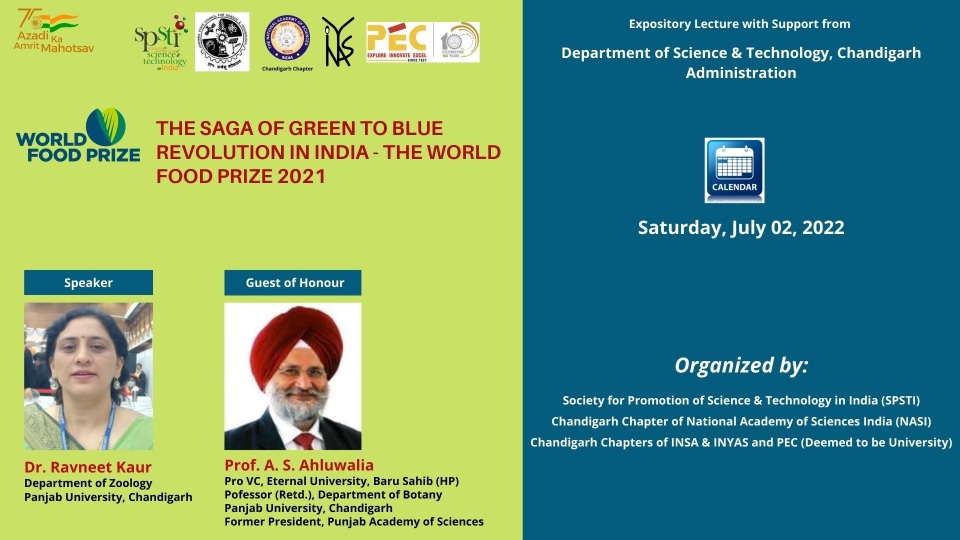The Saga of Green to Blue Revolution in India
In 1944, A. V. Hill submitted his report on Scientific Research in India to the then Government of India, wherein he highlighted the fundamental problems of India were not really physical, chemical or technological, but a complex of biological one, centrally around its population, health, food and natural resources. In this backdrop India has responded fairly well in launching its mission and achieving its goals. These opinions were shared by Dr. Ravneet Kaur, Department of Zoology, Panjab University, Chandigarh the title of whose lecture was “The Saga of Green to Blue Revolution in India – the World Food Prize 2021”. She was speaking at the web-series on International Awards in Sciences – Nobel, Turing, Abel and World Food Prize organized by the Society for Promotion of Science and Technology in India (SPSTI).
World food prize is considered equivalent to Nobel Prize and since its inception in 1986 it has been awarded to 52 individuals with seven laureates from India. Dr. M. S. Swaminathan, Father of Green Revolution in India, was first one to receive this award. Several other Indians have received this award including Dr. Verghese Kurlen, the Mil Man of India, Dr, Gurdev Singh Khus, for global supply of rice, Dr. B. R. Barwale, father of the Indian Seess Industry, Dr. Surinder K. Vasal for maize miracle. Dr. Modadugu Vijay Gupta received the World Food Prize in 2005 for explosive increase in aquaculture by advocating polyculture technique of raising multiple species of fish in one pond. He also developed Genetically Improved Farmed Tilapia (GIFT), which is the second most cultured fish species in the world. He taught poor and landless people to recycle farm waste to support and grow larger fish stock. With his intervention 2000 onwards the inland fish production started seeing a peak in India.
In 2021 the world food prize has been awarded to Indian origin Dr. Shakuntala Haraksingh Thilsted, who is the first Asian woman to receive this award for her pioneer work in addressing the problems of hunger and malnutrition by improving nutrition on fish-based food system. She worked on developing holistic, nutrition-sensitive approaches to aquaculture and food system and including women empowerment. She demonstrated the small fish species which are eaten whole cater to need of bioavailable calcium, vitamin A, iron and zinc and these have high levels of multiple essential micronutrients and fatty acids which are affordable and locally available food. These offer life-changing benefits for children’s cognitive development in their first thousand days of life and the nutrition and health of their mothers. She developed the sustainable model for aquaculture by advocating polyculture technique, as given by Dr. Modadugu, by introducing the small indigenous fish species. She shared there is loss of small indigenous fish species in India due to pollution, pesticide use in paddy fields, shrinking suitable habitat, over exploitation and other anthropogenic activities. To control this need based planning for conservation and management strategies are the need of hour. She shared the scaling up of inland aquaculture won’t cause any problem if done intelligently and is apt considering the water scarcity we are facing. But she also cautioned that farmers in Punjab, Haryana and Andhra Pradesh are converting ponds into salt water ponds which can lead to increase in salinity of agricultural land.
India is slipping down its position in Global Hunger Index and is showing no improvement in its health and nutritional status posing a great challenge for fisheries institutes and government schemes. In present circumstances, aquaculture and fisheries seems to be best supplements to food grains and can contribute to achieving sustainable development goals. India should focus more on research pertaining to fish nutrition and related filed.
She also shared the work done at the fish and fisheries laboratory I Panjab University where researches are going on using the fish scale waste as source of biomaterial, fish as biomonitoring tool and also studying fish eyes toxicology to understand the quality of water. She said this is the interface of agriculture, fish farming and fish industry.
Prof. A. S. Ahluwalia was Pro VC, Eternal University, Baru Sahib, HP and Professor (retd.), Dept. of Botany Panjab University, Chandigarh and Former President, Punjab Academy of Sciences was Guest of Honour on the occasion, introduced by Prof. Prof. K. K. Bhasin, FNA, Prof. Emeritus, Dept. of Chemistry, Panjab University, Chandigarh. The lecture was organised in association with Chandigarh Chapter of the NASI and Chandigarh chapters of INSA & INYAS and Punjab Engineering College (PEC) (Deemed to be University), Chandigarh and with support from the Department of Science & Technology, Chandigarh Administration. It was streamed live at 11.00 am on July 02, 2022 through Zoom and Facebook.
Also present on the occasion were Shri Dharam Vir, President, SPSTI; Prof. Arun K. Grover, former Vice Chancellor of Panjab University and Vice President SPSTI; Prof. Keya Dharamvir, General Secretary, SPSTI; and many other eminent scientists. The session was much appreciated by the audience and followed with lively questions and discussion.


